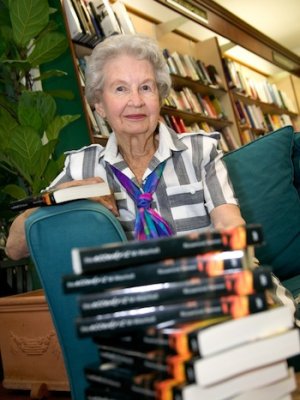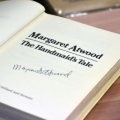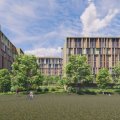
Prominent alumna and benefactor Dr Rosamond Siemon demonstrates her continued commitment and esteem for UQ with a personal tribute to the late Sir Zelman Cowen, former UQ Vice Chancellor.
Dr Siemon’s tribute reflects on a difficult period for the University during the 1970s and how Sir Zelman Cowen’s foresight and passion helped shape UQ into a world-leading institution.
A well-known historian and author, Dr Siemon (Bachelor of Arts Honours, 1989 and Doctor of Philosophy, 1995) has remained dedicated to her alma mater. From 1972 to 1981, Dr Siemon worked as an alumni officer at the University and was an elected member of the Convocation of UQ.
At the age of 77, Dr Siemon combined her passion for history and the University by publishing The Mayne Inheritance, a historical account of Patrick Mayne’s rise to wealth and influence and his family’s legacy to UQ.
Dr Siemon is planning her own legacy through an endowed fellowship in medical research. The fellowship will add to Dr Siemon’s existing support of more than $250,000 to the University to date, including a $30,000 endowment for the Dr Rosamond Siemon Postgraduate Renal Research Scholarship.
Dr Rosamond Siemon's personal reflection on Sir Zelman Cowen and the period is below:
The Right Honourable Sir Zelman Cowen PC, AK, GCMG, K.StJ.KT
Born in Melbourne 7-10-1919
Died in Melbourne 8-12-2011, aged 92
Vice Chancellor of The University of Queensland 1970 – 1977
Governor General of Australia 1977 – 1982
Sir Zelman’s career was marked by compassion and intellectual rigour and he had an unhesitating acceptance of people – even those he judged severely.
The son of Jewish migrants, at age 15 he was Co-Dux of Scotch College, Melbourne and at age 19 at Melbourne University he was appointed an extension lecturer in Political Philosophy.
After topping his year in all of his subjects and taking honours degree in arts and law, he won a Rhodes Scholarship in 1940. As at that time he was serving in the Australian Navy, he deferred the scholarship until after the war. He married Anna Wittner of Melbourne and they both moved to England. Again, he was Dux, this time in 1947 in Oxford postgraduate Law School.
Between Oxford and returning to the University of Melbourne in 1951 he worked as a legal consultant to the British Occupation Army in Germany.
He returned to Melbourne at age 31 and held the position of Dean of the Faculty of Law and Professor of Public Law.
In 1966 he was appointed Vice-Chancellor at the University of New England and four years later accepted the position of Vice-Chancellor of The University of Queensland.
1970 was a very testing time in the academic world. The anti-Vietnam war protests were at the base of a much wider phase of student unrest, and The University of Queensland campus was no exception. The Cowens were very much on the receiving end.
It was not unusual for Zelman to be confronted with a restless, chanting mob. He would stand his ground, facing them, with a very quiet dignity, and reply “I hear what you say, but have you considered ________?”.
Then he would put forward a totally rational answer that gave the students food for thought. Eventually, he became well-regarded by some formerly restless groups who labelled him “Super Zel”.
Zelman’s role at UQ was a complex one – a rapidly growing student population; an incomplete war-retarded campus; an urgent need to widen the range of curriculum; a need for money for buildings, and more staff to cope with the shortfall.
An early task was to foster the formation of an Alumni Association so that graduates would maintain their links with their alma mater and grow into a supportive body.
A connoisseur of the arts, with a strong belief that the arts should bring a quality and dimension of richness and maturity to the life of a nation, he was determined to move the University’s valuable art collection from its packing cases in the basement and set up an art gallery and arts course in the Forgan Smith building.
The Alumni Association cooperated with a series or profitable social functions and the tower of the Forgan Smith building was soon converted to include a gallery to house the University’s large and valuable collection of art works and an art department under the direction of lecturer, Nancy Underhill.
Next, at Zelman’s request, the Alumni Association financed the creation of a teaching garden down by the river for the Faculty of Agricultural Science. A following big project was the erection of the Mayne Hall, named to recognise the University’s largest benefactors – the Mayne family. It was a dual purpose building – primarily so that graduation ceremonies could at last be held on campus instead of at the Brisbane City Hall.
Part of Zelman’s wide ranging thinking was to have an all-glass wall on the higher side of the Hall so that the graduates, on their important occasion, could look from inside the Hall across the lawn and see the University buildings from where they had received their education. He envisioned the rich tones of a pipe organ to usher graduands to their seats and to add dignity to the rendering of ‘gaudeamus igitur’.
Here, once again, the Alumni made the expense affordable. The cost of the special world-class pipe organ and the building of Mayne Hall were defrayed in part by the many successful concerts that attracted full houses for many years before the increase in student numbers necessitated further expansion. Under a later Vice Chancellor, a larger graduation hall was built and Mayne Hall became the University Art Museum housing the greatly expanded art collection.
Both the Cowens (Zelman and Anna) were committed to The University of Queensland in a very wide sense. From the start of his appointment, his involvement was wide ranging.
A Vice-Chancellor’s house was to be built, and he saw to it that it was planned with a view to saving the University money. As Vice Chancellors have a certain amount of entertaining to do, their home included a strategically suitable area – handy to the kitchen for catering, but separate from the privacy of their residence. It was most successful planning. Anna held monthly mornings for staff wives, and thoughtfully produced a couple of mature-age students to babysit their children.
Zelman had ideas for money-raising functions to bolster campus facilities. The public area of the house was ideal for classical concerts catering for 100 guests each time. They were organised by the Alumni Association. He personally paid for the grand piano to be tuned each time it was moved between the music department and their home. The supper was all at their expense and his cooperative, very helpful wife, Anna, prepared it in their kitchen.
After the drastic 1974 floods, when sporting fields at the lower areas of the campus were left a vast, slimy, smelly, mudscape, visible among the volunteer workers were the Vice-Chancellor and his wife.
His goal in every sphere was success, and he made it his task to ensure that his personal contributions to any venture assisted that success. Under his wise, hands-on leadership, the student unrest settled down and The University of Queensland and its nation-wide good reputation expanded.
After the Governor-General, John Kerr, sacked the Whitlam Government in 1975 and Malcolm Fraser’s coalition won office, the public discontent triggered by Kerr’s action remained. Fraser settled it by appointing Zelman Cowen, a man of integrity, dignity and grace, to be the 19th Governor-General of Australia. He held that office from 1977 to 1982 – a role which he later described as “totally unexpected – the greatest experience of my life”.
In 1982, Zelman elected not to take another term and returned to his beloved Oxford as Provost of Oriel College, where he remained until 1990. During this time he took on the position of Chairman of the British Press Council. On his return to Australia he took up the Chairmanship of Fairfax and continued to take part in public debates on a wide range of issues.
Zelman’s last years were marred by the onset of Parkinson’s disease, but with the gentle support of his wife, Anna, and their four children: Simon, Nick, Kate and Ben, he remained a man whose temperament and nature in the face of final decline were constant and truly magnificent.
.jpg)


.png?itok=xWvYRDbm)




.jpg?itok=A3VEKM1Y)


